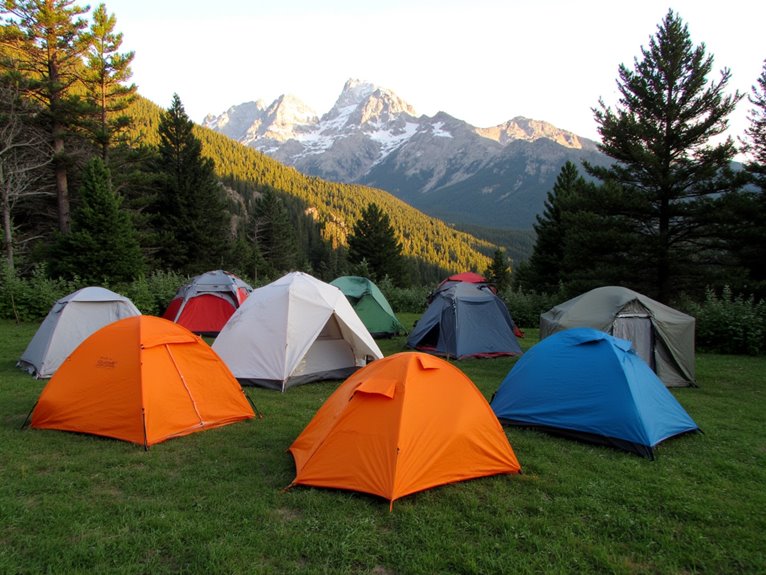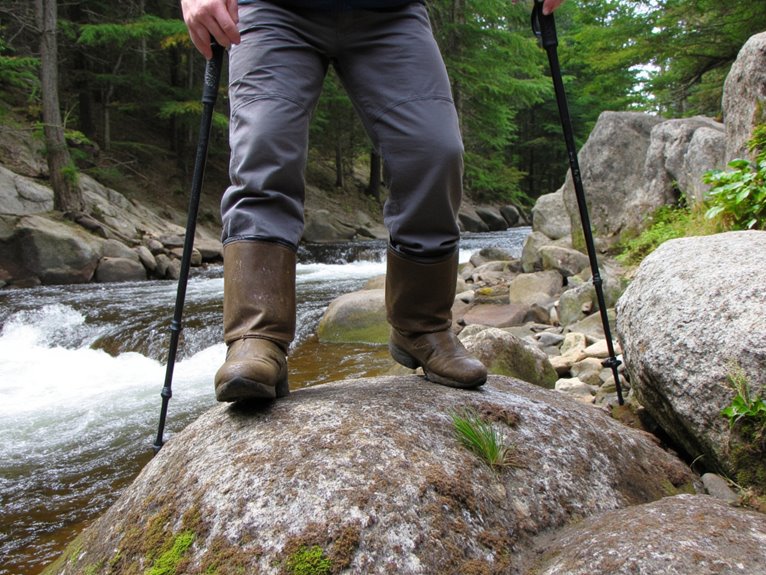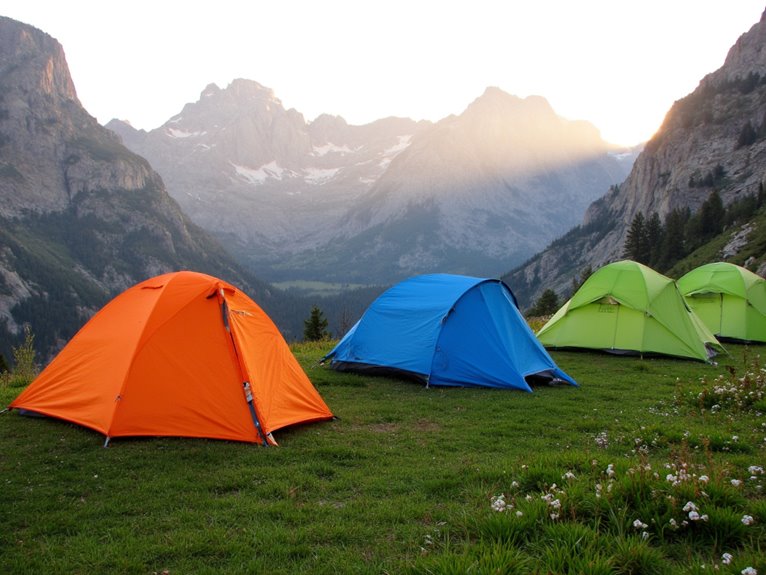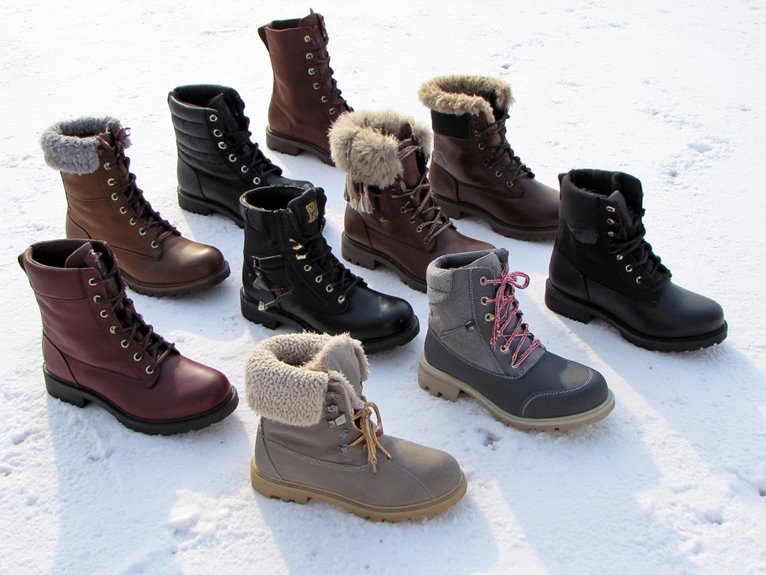Best Camping Shelter
I’ve tested these top camping shelters across diverse conditions: the Kelty Noah’s Tarp offers versatile 68D polyester protection with 800mm waterproofing, while the FREE SOLDIER 10×10.5ft tarp delivers 2500 PU rating at just 2.2 pounds. The Alvantor Screen House provides instant pop-up setup for 6-15 people with UPF 50+ protection, and the GEERTOP 17×10ft tarp covers large groups with premium materials. Each excels in specific scenarios, and understanding their technical specifications will help you select ideal protection.
We are supported by our audience. When you purchase through links on our site, we may earn an affiliate commission, at no extra cost for you. Learn more. Last update on 25th November 2025 / Images from Amazon Product Advertising API.
Notable Insights
- Kelty Noah’s Tarp offers versatile sizing (9ft-16ft), waterproof construction, and lifetime warranty for 1-20 people.
- Screen House Tent provides 117 sq ft bug-protected space with magnetic doors and outdoor entertainment features.
- FREE SOLDIER Tarp delivers lightweight portability at 2.2 pounds with excellent 4.7-star rating from thousands of reviews.
- Alvantor Pop-up Gazebo features instant setup for 6-15 people with UPF 50+ protection and 360° ventilation.
- Consider shelter size, weather protection level, setup time, weight, and material durability when selecting camping shelters.
Kelty Noah’s Tarp Sun Shelter and Multi-Use Awning Rainfly
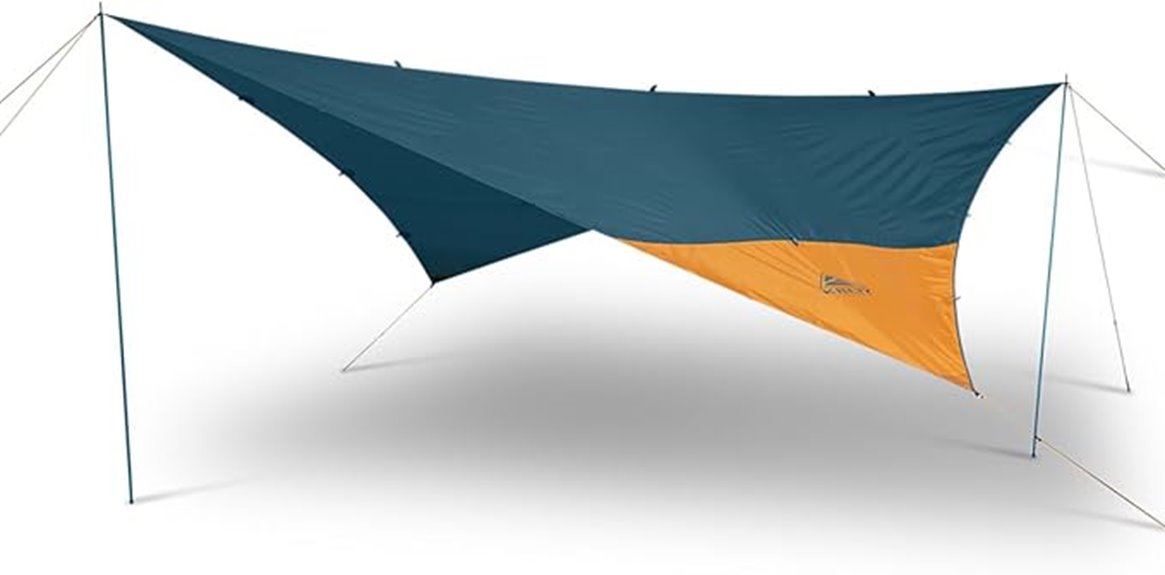
The Kelty Noah’s Tarp excels for outdoor enthusiasts who need one shelter that handles multiple scenarios. You’ll get three size options: 9ft x 9ft, 12ft x 12ft, and 16ft x 16ft configurations. The 68D polyester construction delivers 800mm HH waterproofing with fully taped seams.
At 0.86 kg, it’s lighter than pop-up alternatives while covering groups from 1-20 people. You’ll find multiple reinforced guyout points enable versatile setups for hammock camping, picnic table coverage, or rain protection. The tarp performs well in wind conditions thanks to sturdy corner guylines.
Setup flexibility works with various pole types, though larger sizes challenge solo deployment. You’ll get included guylines and a stuff sack with Kelty’s Limited Lifetime Warranty backing your investment.
Best For: Outdoor enthusiasts who need a versatile, lightweight shelter that can handle multiple scenarios from hammock camping to group sun protection across various outdoor activities.
Pros:
- Lightweight at 0.86 kg compared to pop-up alternatives while offering waterproof protection with 800mm HH rating and fully taped seams
- Multiple reinforced guyout points and sturdy corner guylines enable versatile setups and perform well in windy conditions
- Three size options accommodate groups from 1-20 people and comes with Kelty’s Limited Lifetime Warranty
Cons:
- Larger sizes are difficult to set up solo, limiting convenience for single users
- Does not pack down small and is heavier than some other tarp alternatives
- Poles are not included, requiring separate purchase or sourcing for optimal setup
FREE SOLDIER Waterproof Portable Tarp Shelter (Brown 10×10.5ft)
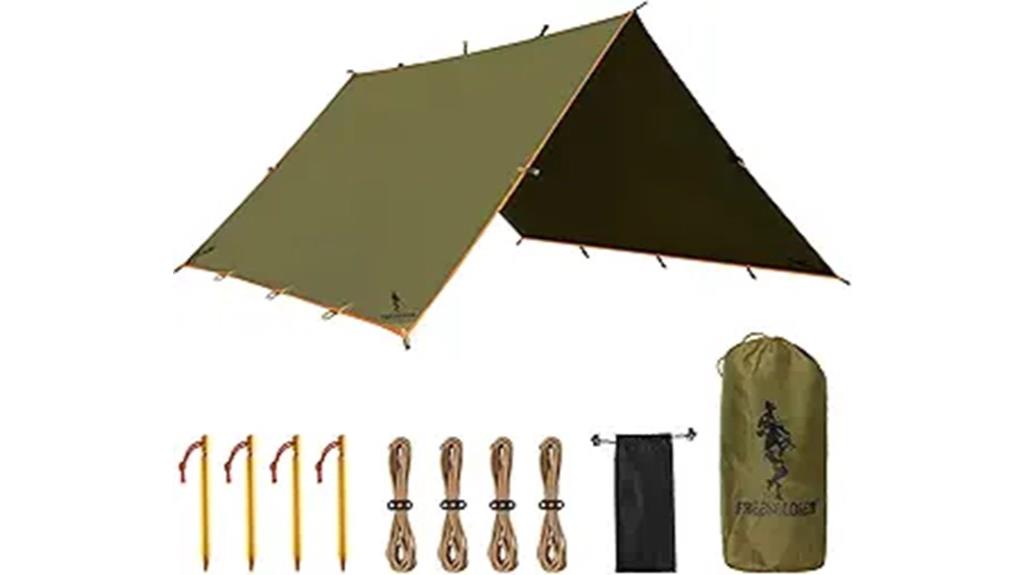
Outdoor enthusiasts who demand reliable weather protection without sacrificing portability will find the FREE SOLDIER Waterproof Portable Tarp Shelter an exceptional choice. This 10×10.5ft shelter uses 210T ripstop polyester fabric with a 2500 PU waterproof rating, ensuring complete weather protection. You’ll appreciate its tear-resistant construction and reinforced ridgeline seam that prevents water penetration.
At 2.2 pounds, it packs into a compact stuff sack for easy transport. The shelter includes 19 guy points and 5 grommets for versatile setup configurations. You can deploy it as ground cover, hammock shelter, or traditional tarp. Customer ratings of 4.7 stars from 3,658 reviews confirm its reliability for backpacking, hunting, and camping adventures.
Best For: Outdoor enthusiasts who need a versatile, lightweight shelter for backpacking, camping, hunting, and fishing while requiring reliable weather protection and multiple setup configurations.
Pros:
- High waterproof rating (2500 PU) with tear-resistant 210T ripstop polyester fabric and reinforced seams for superior durability
- Lightweight at 2.2 pounds yet provides generous 10×10.5ft coverage with 19 guy points and 5 grommets for versatile configurations
- Excellent customer satisfaction with 4.7/5 stars from over 3,600 reviews and ranked #2 in camping tent tarps
Cons:
- Stakes could be improved based on customer feedback suggesting they may not be as durable as the tarp itself
- At 2.2 pounds, it’s heavier than some ultralight alternatives for weight-conscious backpackers
- Limited color option with only brown available, which may not suit all preferences or environments
Camping Tarp with Poles, 15×12.5FT Waterproof Oxford Cloth Canopy (Green)
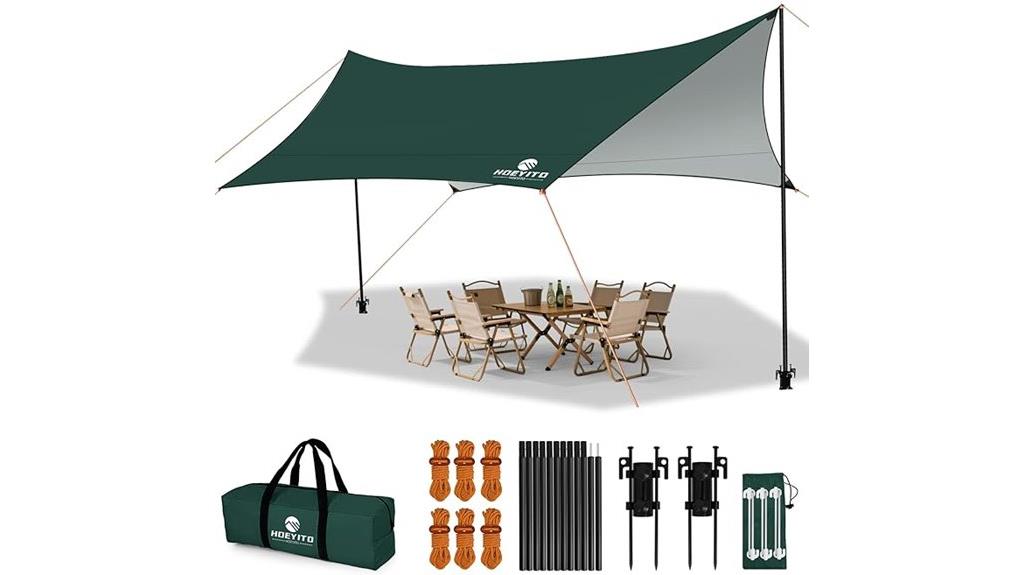
When you need shelter that accommodates 8-10 people without sacrificing portability, this 15×12.5-foot camping tarp delivers professional-grade protection in a manageable 8.9-pound package. The 210D Oxford cloth construction features PU8000mm waterproofing that blocks heavy rain completely. Its inner silver coating eliminates 99.99% of UV radiation, outperforming lighter 150D and 210T alternatives.
Two adjustable poles extend from 30.9 to 88.7 inches, creating customizable height configurations for varied terrain. The included retainers provide stable anchoring in sand, gravel, or soft ground conditions. Your setup receives extensive support through six fluorescent stakes, six guy lines, four tent stakes, and two retainers—30% more hardware than comparable products.
Best For: Large groups of 8-10 people who need reliable, weatherproof shelter for camping, beach outings, or outdoor events and want professional-grade protection with easy setup.
Pros:
- Exceptional weather protection with PU8000mm waterproofing and 99.99% UV blocking silver coating
- Comprehensive hardware package includes 30% more accessories than competitors with adjustable poles and multiple anchoring options
- Large coverage area (15×12.5 feet) accommodates groups while remaining portable at 8.9 pounds
Cons:
- At 8.9 pounds, it’s heavier than ultralight backpacking options for solo hikers
- Large 15×12.5 foot footprint may be difficult to set up in tight camping spaces
- Requires multiple anchor points and guy lines for proper setup, making it more complex than simple pop-up shelters
Forceatt 12x14FT Waterproof Camping Tarp with 2 Poles
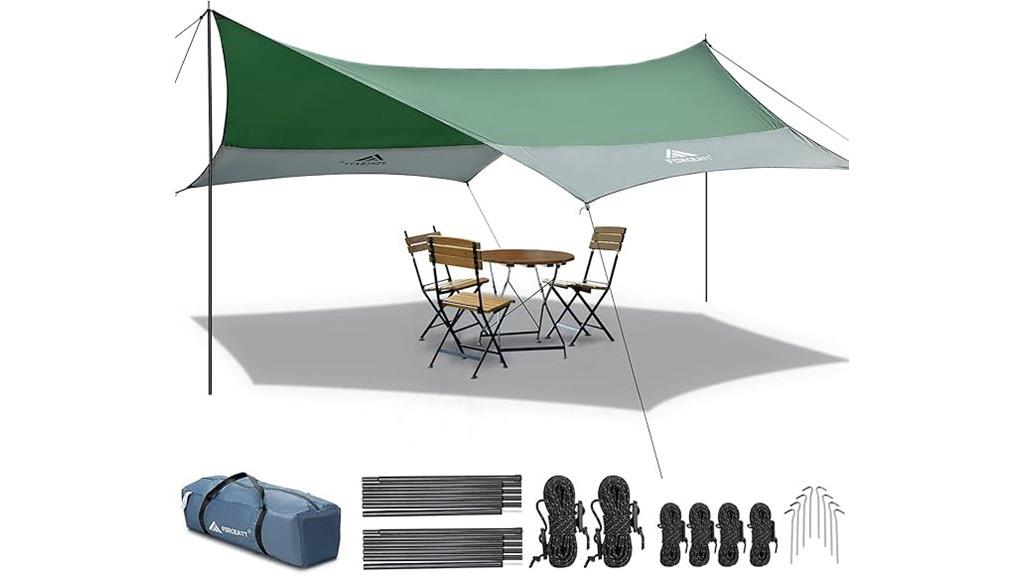
Outdoor enthusiasts seeking versatile weather protection will find the Forceatt 12x14FT Waterproof Camping Tarp delivers reliable shelter with impressive adaptability. This 5.6-pound tarp features 150D Oxford fabric with PU3000 waterproof coating, providing substantial rain protection and UV resistance. You’ll get complete setup accessories including two 2.1-meter iron poles, six binding points, eight stakes, and wind ropes. The compact storage bag measures 16.5 x 7 x 6.7 inches for easy transport. However, you should consider pole durability concerns reported by users, particularly in windy conditions. The tarp functions effectively as a sun shelter, picnic mat, or ground cover across multiple outdoor activities.
Best For: Outdoor enthusiasts who need versatile, lightweight weather protection for camping, hiking, and picnics but won’t encounter extremely windy conditions.
Pros:
- Excellent waterproof protection with PU3000 coating and UV resistance for reliable all-weather shelter
- Complete setup kit included with poles, stakes, and ropes, plus compact storage bag for easy transport
- Versatile functionality as sun shelter, picnic mat, or ground cover across multiple outdoor activities
Cons:
- Iron poles may lack durability and struggle in strong wind conditions according to user reports
- Some customers have reported receiving used or damaged products
- Performance may be inadequate in severe weather conditions despite waterproof rating
GEERTOP Large Camping Tent Tarp Outdoor Waterproof Shelter (17 × 10 ft)
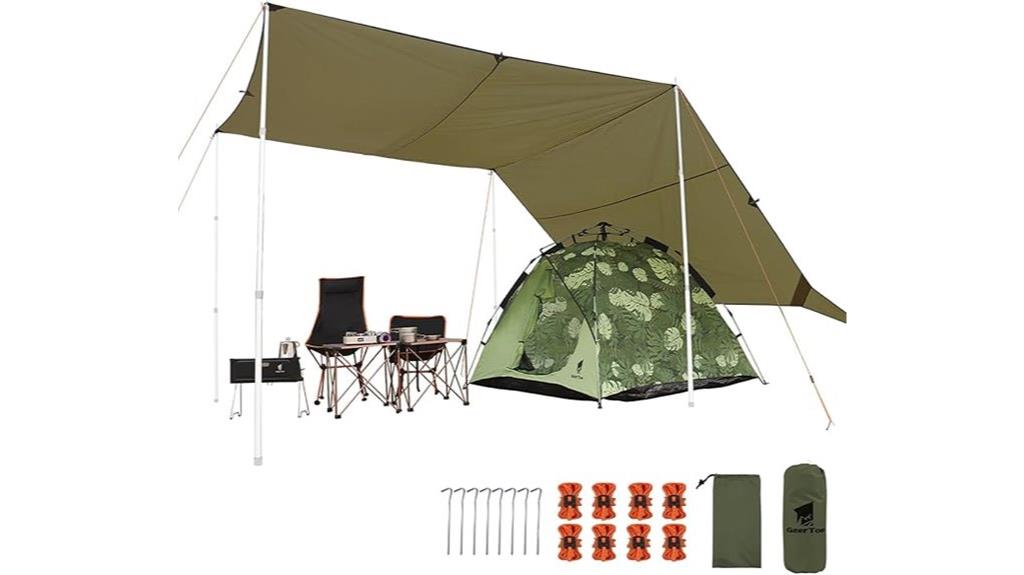
The GEERTOP Large Camping Tent Tarp delivers 170 square feet of waterproof coverage for campers who need reliable protection without carrying excessive weight. At 3.3 pounds, this 17.2 x 10-foot shelter uses 210T polyester fabric with PU3000mm waterproof rating and UV50+ protection. You’ll get tear-resistant durability against punctures and abrasions.
The package includes eight reflective guy ropes and aluminum stakes, though you’ll need to source poles separately. This tarp covers four-person tents, double hammocks, or standard vehicles effectively. It works across diverse environments from beaches to mountain campsites while providing adequate ventilation. Customer ratings average 4.2 stars from 197 reviews, ranking #20 in camping tarps.
Best For: Campers, hikers, and outdoor enthusiasts who need lightweight, waterproof shelter coverage for tents, hammocks, or vehicles across diverse environments.
Pros:
- Large 170 square feet of coverage at only 3.3 pounds for excellent portability
- Strong waterproof protection with PU3000mm rating and UV50+ sun protection
- Versatile use across multiple outdoor activities and environments with good ventilation
Cons:
- Poles not included, requiring separate purchase or sourcing for setup
- Setup complexity may increase without included support poles
- Some customers had misconceptions about what was included in the package
Factors to Consider When Choosing a Camping Shelter
I’ve tested countless camping shelters over the years, and choosing the right one requires evaluating five essential factors that’ll determine your comfort and safety in the wilderness. You’ll need to assess size and capacity requirements for your group, the weather protection level needed for your camping conditions, and how quickly you can set up the shelter when conditions deteriorate. Weight and portability become vital for backpacking trips, while material quality and durability determine whether your investment will last through multiple seasons of use.
Size and Capacity
Five key measurements determine whether a camping shelter will meet your needs: floor area, peak height, packed dimensions, weight, and setup complexity. I’ll start with floor area, which directly impacts how many people you can accommodate. A 10×10 ft tent provides 100 square feet—perfect for small groups. For larger gatherings, a 12×12 ft canopy covers tables for 6-8 people comfortably.
Peak height matters for standing room and comfort. Most shelters range from 6.5 to 7.5 feet. Weight affects portability considerably. Backpacking shelters under 2 lbs offer mobility, while heavier models provide stability.
Setup complexity increases with size. Larger structures need more time and additional hands. Consider your group’s experience level when selecting shelter dimensions.
Weather Protection Level
Beyond guaranteeing adequate space for your group, weather protection determines whether your camping trip succeeds or becomes miserable. I recommend shelters with waterproof ratings of 3000mm or higher for heavy rain protection. Lower ratings won’t withstand severe conditions effectively.
Look for taped seams and reinforced corners. These features prevent water leakage and guarantee stability during windy conditions. Choose ripstop fabric over standard polyester—it’s more tear-resistant and provides better longevity.
For sunny locations, select materials with UPF ratings of 50+ to block harmful UV rays effectively. Don’t overlook ventilation features like mesh panels. They reduce condensation and improve comfort during varied weather conditions. Your shelter’s material choice directly impacts its weather protection capabilities, so prioritize quality construction over budget alternatives.
Setup Time Required
Setup time directly affects your camping experience, especially when you’re racing against darkness or severe weather. Pop-up shelters excel here, requiring under 60 seconds for complete assembly. Traditional dome tents typically demand 10-15 minutes with their multi-component designs.
I recommend prioritizing simple construction when speed matters. Automatic pop-up mechanisms eliminate guesswork entirely. Color-coded pole systems reduce assembly time by 40% compared to unmarked alternatives. Tarps offer the fastest setup but require practice for proper tensioning.
Complex shelters with vestibules and multiple guy lines increase setup duration considerably. Weather conditions compound these challenges—wind can triple assembly time while rain makes pole threading difficult. Stakes and guy lines add 3-5 minutes to any setup. Consider your skill level and typical camping conditions when evaluating setup requirements.
Weight and Portability
When backpacking into remote areas, every ounce counts toward your overall pack weight and hiking endurance. I recommend prioritizing shelters weighing around 0.86 kg for ideal transport efficiency. These lightweight options greatly reduce fatigue during extended treks while maintaining essential protection features.
Weight distribution matters as much as total mass. Shelters under 1.5 kg offer the best balance between durability and portability for multi-day expeditions. I’ve found that compact designs pack smaller in backpacks, maximizing available space for other gear.
Most portable shelters include dedicated carrying bags that enhance organization and transport convenience. However, don’t sacrifice weather protection for weight savings alone. The lightest shelter won’t help if it can’t withstand wind gusts or heavy rainfall during critical conditions.
Material Quality Durability
Three primary factors determine a camping shelter’s material durability: fabric composition, waterproof ratings, and UV resistance. I recommend ripstop polyester and Oxford fabric for their superior tear and puncture resistance. These materials withstand sharp branches and rough terrain better than standard fabrics.
Waterproof ratings matter greatly. Look for PU3000 or higher ratings to guarantee your shelter stays dry during heavy downpours. This rating means the fabric can withstand 3,000mm of water pressure before leaking.
UV protection preserves your investment. UPF 50+ ratings block harmful sun rays that degrade fabric over time. This protection also provides valuable shade.
Reinforced seams and guy lines prove essential for structural integrity. They distribute stress evenly across the shelter, preventing failure points during storms and high winds.
Ventilation and Airflow
While durable materials protect your shelter from external threats, proper ventilation prevents internal problems that can make your camping experience miserable. I prioritize shelters with multiple mesh panels and adjustable vents to control airflow precisely.
Condensation buildup destroys sleep comfort and damages gear. Mesh screens provide dual benefits: they maintain airflow while blocking insects completely. I look for shelters with at least two opposing vents to create cross-ventilation patterns.
Temperature regulation depends on strategic vent placement. Adjustable windows let me fine-tune airflow based on weather conditions. High ceilings and angled roof designs promote natural air circulation, preventing heat accumulation during summer months.
I recommend shelters with vestibule vents and peak ventilation systems. These features work together to eliminate moisture and maintain comfortable interior temperatures throughout varying weather conditions.
Budget and Value
Smart shelter shopping starts with establishing a realistic budget that matches your camping frequency and performance requirements. I recommend investing in higher-quality shelters if you camp frequently, as their superior durability delivers better long-term value despite increased upfront costs.
Examine waterproof ratings and material specifications carefully. Shelters with 3000mm+ hydrostatic head ratings and ripstop nylon construction typically outlast cheaper alternatives by years. Look for features that enhance field performance: quick-setup mechanisms, lightweight materials under 4 pounds, and compact pack sizes.
Customer reviews reveal real-world performance data. I focus on feedback regarding longevity and weather resistance rather than initial impressions. Check warranty terms and return policies before purchasing. Manufacturers offering 2+ year warranties typically stand behind their construction quality, providing additional investment protection.
On a final note
I’ve covered top-performing camping shelters that’ll handle diverse outdoor conditions. Each option offers specific advantages: waterproof tarps for minimalist setups, screened gazebos for bug-free dining, and privacy tents for personal needs. Your choice depends on group size, weather exposure, and intended use. Consider factors like setup time, packed weight, and durability when selecting your shelter. These models provide proven protection and functionality for successful camping experiences.

